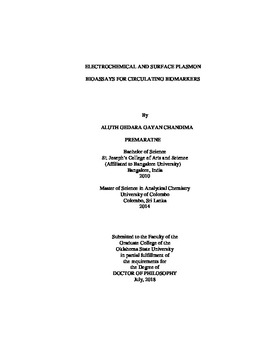| dc.contributor.advisor | Krishnan, Sadagopan | |
| dc.contributor.author | Premaratne, Aluth Gedara Gayan Chandima | |
| dc.date.accessioned | 2019-07-19T15:19:58Z | |
| dc.date.available | 2019-07-19T15:19:58Z | |
| dc.date.issued | 2018-07 | |
| dc.identifier.uri | https://hdl.handle.net/11244/321014 | |
| dc.description.abstract | To address analytical detection needs, sensitive and selective assay methodologies are of great importance. Compared to simple buffer medium, a great challenge exists in detecting ultra-low levels of biomarkers in clinical matrices due to their inherent complexity and interferences posed by non-specific molecules. In addition, small molecules do not yield measurable assay signal changes compared to large biomolecules. My thesis research is focused on designing nano-biological interfaces to detect small and large molecules at low parts-per-billion and femto/picomolar concentrations in complex biofluids (serum and urine samples). Compared to harsh and tedious chemical carboxylation, non-covalent carboxylation of multiwalled carbon nanotubes by π-π stacking 1-pyrenebutyric acid retains the innate sp2 structure and electronic properties of the nanotubes and offers surface carboxyl groups for stable covalent amine coupling of a large amount of enzymes, thus improving the sensitivity of the assay. Chapter 2 demonstrates the first pyrenyl carbon nanostructure modified enzymatic bioelectrode for amperometric detection of urine formaldehyde at clinically relevant parts-per-billion levels with selectivity and wide dynamic range. Subsequently, we explored the low dielectric permittivity and intrinsic plasmonics of graphene for the detection of serum glutamic acid decarboxylase autoantibody (GADA). Graphene-based electrochemical immunosensing approach is advantageous due to its additional applicability for surface plasmon based validation and binding strength analysis with surface immobilized GAD-65 antigens (Chapter 3). My thesis focused on the third class of biomarkers, microRNAs, which are small oligonucleotides with 21-25 bases. To develop the microRNA assay with quantitative characterization, surface plasmon resonance imaging (SPRi) coupled with quartz crystal microbalance (QCM) was designed (Chapter 4). Gold nanoparticles (Au NPs) were linked to the oligonucleotides to increase the detection sensitivity upon hybridization with the selective capture oligonucleotide immobilized on the sensor surface with minimal non-specific signals. Often, cancer and other similar health disorders have been shown to be related to various types of biomarkers. Hence, in Chapter 5, we designed a multiplex assay platform for combined measurement of proteins and microRNAs. For this multiplex assay, we synthesized iron-gold bimetallic core/shell nanoparticles (Fe3O4@Au NPs) that displayed a greater plasmonic signal amplification than either Fe3O4 or Au NPs. | |
| dc.format | application/pdf | |
| dc.language | en_US | |
| dc.rights | Copyright is held by the author who has granted the Oklahoma State University Library the non-exclusive right to share this material in its institutional repository. Contact Digital Library Services at lib-dls@okstate.edu or 405-744-9161 for the permission policy on the use, reproduction or distribution of this material. | |
| dc.title | Electrochemical and surface plasmon bioassays for circulating biomarkers | |
| dc.contributor.committeeMember | El Rassi, Ziad | |
| dc.contributor.committeeMember | Bunce, Richard A. | |
| dc.contributor.committeeMember | Nelson, Toby Larue | |
| dc.contributor.committeeMember | Lucas, Edralin Aguinaldo | |
| osu.filename | Premaratne_okstate_0664D_15939.pdf | |
| osu.accesstype | Open Access | |
| dc.description.department | Chemistry | |
| dc.type.genre | Dissertation | |
| dc.type.material | Text | |
| dc.subject.keywords | bioconjugation||clinical matrices||electrochemical and spr assays||multiplexed detection||small and large molecule markers||surface nanomodifications | |
| thesis.degree.grantor | Oklahoma State University | |
